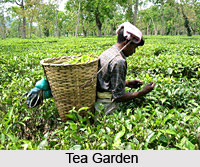 The economy of Assam is mainly agricultural. There is a widespread practice of traditional farming techniques and low practice of modern techniques. About seventy five percent of the population depends on agriculture and sixty nine percent of the work force in the state is engaged in agricultural activities. Rice is the staple diet of the people. Most of the people are engaged in the cultivation of rice. Other agricultural products cultivated are pulses, jute, tea and fruits. Sugarcane, potatoes, cotton, oil seeds, coconut and areca nut cultivation is also practiced on a substantial scale. Sixty seven percent of the area is cultivated by rice. The fruit crops cultivated are oranges, bananas, pineapples and mangoes.
The economy of Assam is mainly agricultural. There is a widespread practice of traditional farming techniques and low practice of modern techniques. About seventy five percent of the population depends on agriculture and sixty nine percent of the work force in the state is engaged in agricultural activities. Rice is the staple diet of the people. Most of the people are engaged in the cultivation of rice. Other agricultural products cultivated are pulses, jute, tea and fruits. Sugarcane, potatoes, cotton, oil seeds, coconut and areca nut cultivation is also practiced on a substantial scale. Sixty seven percent of the area is cultivated by rice. The fruit crops cultivated are oranges, bananas, pineapples and mangoes.
The state is richly gifted with natural resources as abundant rainfall, alluvial soil, rich and diverse plant and animal genetic base. Over the decades, the development of agriculture has been low but still the state is not lagging behind but is unable to meet its own requirements in many agricultural commodities. Forests are an important part of Assam`s economy. Timber and bamboo form the major part of the forest. Assam is rightly known for its excellent tea, which is one of the major cash crops. 15 percent of the world`s total output of tea comes from the tea gardens of Assam.
 Assam is an important producer of silk. Production of tusser and other silks and weaving of fabrics is an important occupation of the people. Other types of industries are food products, wood products, chemical products, and non-metallic mineral products. Tea and oil are of prime importance in Assam`s economy and also plays a significant role in the economy and life of the state. In Assam, mining is concentrated mainly to four minerals as coal, oil, gas, limestone and sillimanite. The most important coalmines in Assam are located in the Ledo and Jaipur areas of upper Assam.
Assam is an important producer of silk. Production of tusser and other silks and weaving of fabrics is an important occupation of the people. Other types of industries are food products, wood products, chemical products, and non-metallic mineral products. Tea and oil are of prime importance in Assam`s economy and also plays a significant role in the economy and life of the state. In Assam, mining is concentrated mainly to four minerals as coal, oil, gas, limestone and sillimanite. The most important coalmines in Assam are located in the Ledo and Jaipur areas of upper Assam.




















